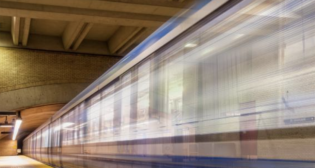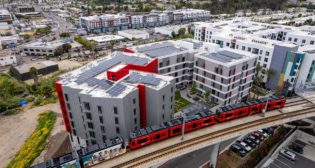
Here come the streetcars
Written by William C. Vantuono, Editor-in-ChiefLight rail transit re-established itself in North America as a serious transportation mode 35 years ago, and LRT’s growth continues apace today. It’s now being complemented by a surge in streetcar development, often in tandem with LRT, and often with rail equipment suppliers standing ready to provide both.
Indeed, industry observers may squabble over what system, or vehicle, defines LRT and what constitutes a streetcar. Talk to suppliers, however, and the distinction, while real enough in terms of design and operation, isn’t an overriding distraction. Put simply, form follows function. Or, if the streetcar moniker fits, wear it.
No wonder, then, that established large equipment manufacturers have been joined by relative upstarts and newcomers to the streetcar industry, often backed by deep pockets of larger, formerly non-rail-oriented companies, to pursue streetcar development.
So far, there’s room for success among many players old and new. CAF USA is handling Cincinnati’s nascent streetcar development, while Brookville Equipment Co., long renowned for its rehabilitation of vintage rolling stock (including streetcars), has landed a Dallas DART order for its new Liberty Streetcar model to serve the Oak Cliff neighborhood. United Streetcar, LLC, a subsidiary of Oregon Iron Works, has struggled to launch its 100 Series line, releasing its first car last fall to hometown Portland, Ore., with a backlog of orders from Tucson, Ariz., and Washington, D.C. Pacifica Marine is performing assembly of Czech Republic-based Inekon’s Trio cars for use in Seattle, as the city and Sound Transit expand their commitment to the mode.
Big names see big potential
The big brand names aren’t asleep at the switch, as they proved during the APTA Annual Expo in October 2011, displaying detailed mockups, often full sized, of new streetcar designs.
In the U.S., Siemens Mobility, long a dominant supplier for U.S. LRT, has modified its S70 design to offer streetcar variants for Atlanta, Ga., as well as for the Sugar House Line in Salt Lake City. Utah Transit Authority, in fact, notes it modified its original order for Siemens S70s in order to supply both its TRAX LRT network and the Sugar House Line, set to open in 2014.
Bombardier Transportation has its hands full handling the largest streetcar order at present, 204 low-floor Flexity vehicles to resupply and upgrade Toronto’s venerable network of 11 streetcar routes. Toronto Transit Commission, along with regional authority Metrolinx, also has turned to Bombardier for roughly 182 light rail vehicles at the same time, generating some confusion in the process (including to reporters).
Northeast of Toronto, Alstom Transport is supplying Ottawa, the Canadian capital, with Citadis Spirit rolling stock the company identifies as streetcars—even as Ottawa’s OC Transpo updates the public on its “new light rail transit line.”
Who’s got the right label, and does it really matter?
“Streetcars and light rail vehicles are similar products; it’s a question of lengths,” and of widths, offers Alstom Transport North America Vice President, Turnkey & Infrastructure Systems Stephanie Brun-Brunet. “We have the flexibility to develop [a vehicle] ranging from 20 meters to 60 meters. The North American market operates at 30 meters, give or take—that’s light rail. The streetcar market, 20 meters or so.”
Alstom is supplying its Citadis Spirit model to serve Ottawa, adjusted for Canadian needs (including climate control) but otherwise quite similar to Citadis models in Europe that, whatever else, are clearly streetcars.
Siemens Rail Systems President Michael Cahill credits the tenacity of Portland, Ore., already an LRT leader, for generating the current streetcar revival. For Cahill, the history lessons don’t stop there. “A lot of people saw it as a ‘small city’ phenomenon, but LA is going the streetcar route aggressively,” Cahill says.
City size, he asserts, is “pretty indiscriminate.”
That spells opportunity for numerous suppliers, but Cahill says eventually a culling likely will occur. “At the beginning of any new wave, there are a lot of interested players,” he acknowledges. “But challenges can be underestimated, and the challenges are certainly still there.”
Like Alstom (and Bombardier), Siemens has sought to time its streetcar efforts to keep pace with North American adaptation. Streetcar construction, and the news surrounding it, “possibly flies under the radar screen because the projects are modest, to begin with. The hope is that it grows into something much bigger. We’ve been keeping an eye on this for several years, and we think the S70 we have is a reflection of that.”
Toronto tests under way
Last month Bombardier began testing its 100% low-floor Flexity streetcars on Toronto Transit Commission’s venerable layout, checking clearances (both overhead and over the street), 8% grades, and other potential sticking points (photo, p. 45). “The Toronto streetcar network is very demanding; therefore, this step is extremely important,” says Bombardier Senior Specialist, Product Management Jacques Drouin. “For now, though, and to ensure minimal disruption to normal traffic, testing occurs in the middle of the night.”
Drouin isn’t bashful about Bombardier’s vision to expand its streetcar options continent wide, using Toronto as a springboard. “We are hopeful that the Toronto vehicle will become a point of reference in the North American market, he says. “Bombardier believes the design is well suited to the growing streetcar market in the U.S. and Canada.”
That market is overdue for filling a transport niche other public transport modes can’t, he continues, “best at replacing saturated bus lines and Bus Rapid Transit (in the LRV version), and can carry more riders in a more comfortable way than other options.”
Hybridized potential becoming reality
Much as the auto industry has moved to incorporate two or more power sources for vehicles, LRT/streetcar suppliers are doing the same for North America, extrapolating from actual European-based experience.
Alstom Transportation’s Aesthetic Power Supply (APS) System is credited by many as the first modern wireless option offered to the market. It taps power units underneath track, with 8-meter-long conduit segments separated by 3-meter insulated joints. Antennae in the APS collector unit send a coded radio signal to the power unit to activate it. Alstom’s APS (originally Alimentation par Sol ) also carries a third power source, a backup battery, in case of emergency.
Siemens Sitras Hybrid Energy System (HES) employs a nickel metal hydride battery, aided by a double-layer capacitor. Siemens says its product can be retrofitted into existing equipment, allowing existing U.S. systems to consider wireless expansion prospects without requiring a fleet overhaul. Siemens claims a battery range of about 8,200 feet, or about 1.5 miles, before recharging is required, with recharging assisted by regenerative braking as well as at station stops.
Bombardier has ready its Flexity Freedom option, using Primove technology employing a conduit line beneath the ground and between the rails. Toronto’s ample overhead obviates this option, but the company sees plenty of future opportunities.
Relative upstart Brookville Equipment Co. hasn’t waited. Its Liberty streetcars, tapped by Dallas and the city’s Oak Cliff neighborhood, will utilize a battery energy storage system (ESS) to power the car’s four traction motors when off-wire. The company says about one mile of the 1.6-mile track will require ESS power, allowing the LRV to cross the city’s Houston Street Viaduct over the Trinity River without the use of catenary, on its route to and from Dallas Union Station.
Brookville says it’s the first to deploy dual-mode modern streetcars in the U.S., but it doubtless will soon have company. Suppliers large and small say the revival of, and return to, city centers across North America help spur the drive for hybridized streetcars.
Says Alstom’s Brun-Brunet, “Ottawa’s Confederation Line will show the potential for potential for U.S. markets” determined to “bring back their city center.”
Bombardier’s Drouin says Toronto once more may be held as the model for cities across Canada, and in the U.S., looking to rail transit “as a solution to their growing congestion and pollution problems.”
Siemens’ Cahill says streetcars are a municipal commitment “by the very nature of steel rails; it’s built to last, and a great opportunity for cities to revive themselves. You’re generating foot traffic, involving pedestrians, and when you have pedestrians that generates business,” and in the longer run a more livable urban environment. Streetcars, in conjunction with LRT, combine to maximize that potential, Cahill says.



